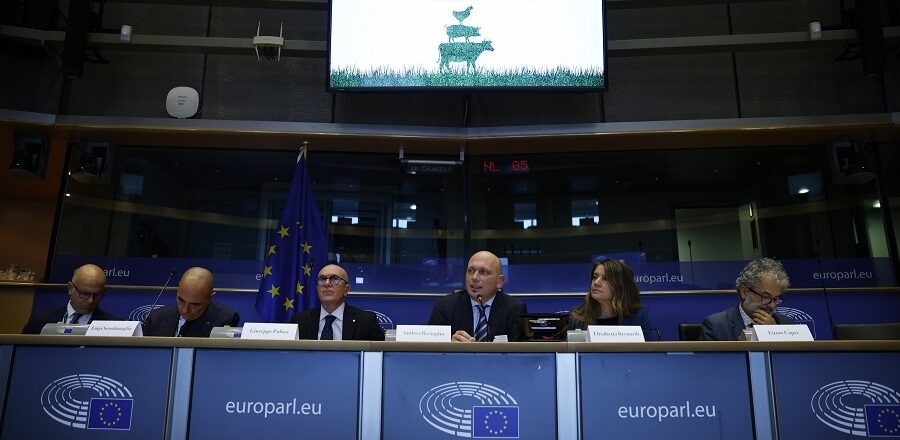
The Temple of the Mediterranean Diet
The Mediterranean Diet, the most famous food model globally, turns ten as an Intangible Heritage of Unesco. To celebrate this anniversary, the Sustainable Meat Project proposes a graphic and conceptual evolution of the food pyramid: the Temple of the Mediterranean Diet, a new iconography for an evolving story.

On November 16th, the recognized and praised Mediterranean Diet celebrates its first ten years as an Intangible Heritage of UNESCO. But what do we know about this famous dietary pattern? Discovered during a scientific study in the 1950s as a common denominator of the olive-growing countries around the Mediterranean Sea, in particular Greece, Crete, and southern Italy, the Mediterranean Diet is immediately recognized as being able to reduce the incidence of cardiovascular diseases by 2-3 times in that geographical area, compared to Northern Europe and the United States of America.
Over the years, myths and legends have been created around the Mediterranean Diet, often overshadowing some of its fundamental messages. “It is time to return to tell the Mediterranean Diet as a set of material and immaterial aspects, where the whole counts more than the individual element,” Giuseppe Pulina says, president of the Sustainable Meat Project. And the proposal to think of a new symbolism suitable to represent its complexity and uniqueness comes from the need to reunite its two great souls, the nutritional and the anthropological and social ones.
The #MediterraneanDiet turns 10 as an #IntangibleHeritage @UNESCO. To celebrate that, #CarniSostenibili proposes an evolution of the #FoodPyramid: The #Temple of the Mediterranean diet. Click To TweetThus the “Temple of the Mediterranean Diet” was born. Recognized and unsurpassed architectural model, the Temple becomes the emblem of these dietary habits, bringing together its social and environmental aspects and the four food categories on the columns: carbohydrates, fruits, vegetables, and proteins. A graphic and conceptual evolution of the food pyramid, a renewed iconography to tell how beyond the balance of nutrients, the Mediterranean Diet is also conviviality, tradition, respect for food seasonality, protection for biodiversity, attention to health. The Mediterranean Diet is culture.
Besides the balance of #nutrients, the #MediteranneanDiet is also #conviviality, care for #tradition, respect for #seasonality of #foods, protection for #biodiversity, attention to #health. Click To TweetYes, this dietary pattern is not a static concept but a force in the continuous transformation that changes with the changing times. Even UNESCO, in 2013, revised and emphasized this aspect. Thus, while the references to ancient Greece are correct, on the other hand, the “frugal abundance” that characterizes it does not arrive at us unchanged from antiquity, but it is the result of mixtures, cultural and social evolutions, continuous discoveries, even geographical ones. America and Asia, like Africa and Europe, contribute to its development. Just think that foods such as corn, potato, tomato, peanut, pineapple, pepper, chilies, cocoa, pumpkin, turkey (which supplants peacock meat) arrive in the Mediterranean cuisines after the American discovery.
You will wait until the 1600s for the “new drugs”: coffee, tea, chocolate, and the spirits that at that time spread with the name of the “spirit of wine.” And what would his balanced menus be without sauce? However, it is necessary to go until 1692 for the first sauce called “Alla Spagnuola” until the mid-1800s for tomato pasta recipes.
The #FrugalAbundance characterizing the #MediterraneanDiet is the result of #Cultural and #Social Evolutions. And #discoveries, even geographical ones. Click To TweetThe Mediterranean Diet is a living, pulsating entity, a process in the continuous movement that integrates different cultures and traditions and leaves room for new foods, “everything in small quantities” remains its mantra. “In this sense – Pulina concludes – meat is also a founding food constantly present, over the millennia, in the culinary elaborations of the Mediterranean peoples who, today, preserve an endless archive of dishes, customs, and traditions linked to this precious food.”
On these subjects, the booklet “Il Mediterraneo, il Tempio della dieta” written by Dr. Elisabetta Bernardi, Dr. Elisa Ascione, and Professor Giuseppe Pulina will be published at the end of December.





